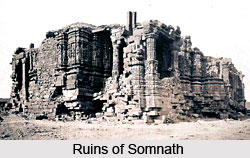Mahmud of Ghazni was the ruler of the Ghaznavi dynasty which claims its origin from the family of Persian rulers. Mahmud of Ghazni was the first ruler who invaded deep into India. He emerged successful in breaking up the armed forces of the Hindu rulers and plundered enormous wealth from India. He was the ruler of the Ghaznavi Empire and turned the city of Ghazni into a wealthy capital and a cultural centre of an extensive empire. The empire originally constituted of modern Afghanistan, north-eastern Iran and eventually north-western India (now Pakistan). Mahmud of Ghazni (971-1030) was the first sultan of the Ghaznavid dynasty in Afghanistan.
 Early Life of Mahmud of Ghazni
Early Life of Mahmud of Ghazni
Mahmud was born on the first of November 971 A.D. He had received fairly good education and had participated in many battles during the reign of his father. After ascending the throne, Mahmud first consolidated his position in Herat, Balkh and Bust, and, then conquered Khurasan. In 999 A.D. Khalifa Al Qadir Billah accepted him the ruler of these places and conferred on him the titles of `Yamin-ud-Daulah` and `Amin-ul-Millah.` Mahmud descended into India, to ransack wealth. Punjab was mainly the territorial acquisition for him. The first large-scale campaign began in 1001 AD. The first expeditions were against the Punjab and north-eastern India. His most important expedition was against the Somnath temple of Gujarat in 1025.
Deeds of Mahmud of Ghazni
Mahmud had already had relationships with the leadership in Balkh through marriage as Abu Nasr Mohammad offered his daughter to Mahmud`s son, Muhammad and his services to the Sultan. After Nasr`s death Mahmud brought Balkh under his control. This alliance was a great help for him during his expeditions into Northern India. Mahmud set out regular raids against the Rajputs. His invasions were particularly directed to those Indian temple towns that were depositaries of great wealth. Nagarkot (Now Kangra), Thanesar (now in Haryana), Mathura (holy city of Uttar Pradesh), Kanauj (Now in Uttar Pradesh), Kalinjar (fortress-city in the Bundelkhand region) and Somnath of Gujarat were the cities of his target. After raiding the temples of Varanasi, Ujjain, Maheshwar, Jwalamukhi and Dwarka, Mahmud`s army destroyed the temples and plundered the temple wealth.
Mahmud was a courageous soldier and an unbeaten commander. He possessed the qualities of leadership and knew how to utilise his wealth and circumstances in the best possible way. He was a good judge of human nature and assigned work and responsibility to others according to their capacities. His army consisted of the people of different nationalities like the Arabs, the Turks, the Afghans and even Hindus. He was a very ambitious man and always attempted to win glory and extend his empire. He had inherited from his father only the provinces of Ghazni and Khurasan. He converted this small inheritance into a mighty empire which extended from Iraq and the Caspian Sea in the west to the river Ganges in the east.
Personal Life of Mahmud of Ghazni
As per Buzurg of Shahriyar, Sultan Mahmud had 9 wives and near about 56 children with up to 32 women. His younger brother was Yusuf SebÂktigin. Sultan Mahmud`s twin sons succeeded him in succession: Mohammad Ghaznavi and Ma`sud Ghaznavi I.
Mahmud was an educated and cultured individual. He was a patron of scholarship and fine arts. He gathered at his court scholars of repute. Al Beruni, the scholar of Turki, Sanskrit, Mathematics, Philosophy, Astrology and History was at his court. Utbi, Farabi, Baihaki, the Iranian poet Ujari, Tusi, Unsuri, Asjadi, Farrukhi and Firdausi who were scholars of repute of his age were all at his court Mahmud established a university, a good library and a museum at Ghazni. He constructed many palaces, mosques, tombs and other buildings in Ghazni. During his rule, Ghazni became not only a beautiful city of the east but also the centre of Islamic scholarship, fine arts and culture. Mahmud was also a just ruler. Mahmud was an extremist Sunni Muslim and was intolerant towards the Hindus and the Shias. He intended to propagate Islam and to establish its glory in India.
Mahmud`s supremacy among his contemporaries was due to his ability and not due to Ins character. Mahmud established an extensive empire, brought peace and opulence within its boundaries, helped in its cultural progress and established the glory of Islam at distant places. Ghazni became the seat of power of Islam and the centre of its progress in culture including education, scholarship and fine arts. The most important achievement of Mahmud of Ghazni was the destruction of the Hindushahi kingdom of Afghanistan. It paved the way for the conquest of India by the Muslims.



















